MedievalReporter.com
Covering history's most marvelous millennium
Join our newsletter!

Covering history's most marvelous millennium
Covering history's most marvelous millennium
The Khazars were part of the greater Turkic world. They established an extensive commercial network on the Russian steppe. Khazaria thus became one of the foremost medieval trading empires. Neighboring christian and muslim empires tried to use the Khazars as a handy buffer state. But they were not easily manipulated: they adopted neither religion.
Proud and independent, Khazaria stood firm on the steppes. This attitude encouraged attacks by other (semi-)nomadic peoples. After centuries of prosperity, jealous neighbors ultimately overran the Khazar state.
This is a short intro from our Medieval Guidebook. Dive deeper into the subject by reading our articles about it.
Right around the start of the Middle Ages, a large Turkic state dominated the Great Eurasian Steppe. It was ruled by a khagan, a Turkic title of imperial rank. That’s why this realm was known as the Göktürk Khaganate – or simply the First Turkic Empire. During the 7th century CE, the Chinese Tang Empire increased the pressure on the eastern flank of the Khaganate. Forced to direct military resources that way, the Göktürks could no longer hold on to the western end of their empire.
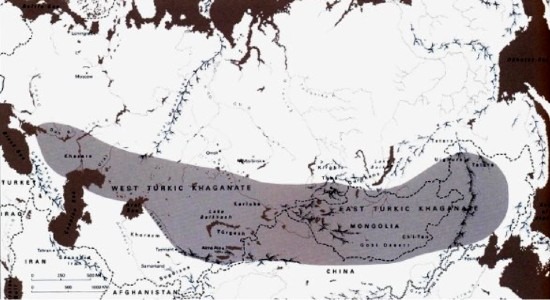
There, on the Russian and Ukrainian steppes, the Bulgars and Khazars (re)emerged from the ashes of the Göktürk Khaganate. At first, the Bulgars seemed to be gaining the upper hand. But over time, Khazar pressure whittled down the Bulgar state. By the end of the 7th century, a formidable Khazar empire had formed in the area. Their reputation rose quickly: Persian kings soon considered Khazaria equal in power to Imperial China and the Byzantine Empire.
On account of their Turkic roots, the Khazars might have been loosely related to the Huns. But the Hunnic Empire had all but disappeared by the time Khazaria came forth from the Göktürk Khaganate. So the Huns and the Khazars occupied different time periods. Their empires do resemble one another in a particular way, though. Because they had so many other peoples, ethnicities and cultures under their belt, the Hunnic and Khazar empires were tolerant multiethnic states.
Especially with regards to religion, Khazaria took a peculiar decision.
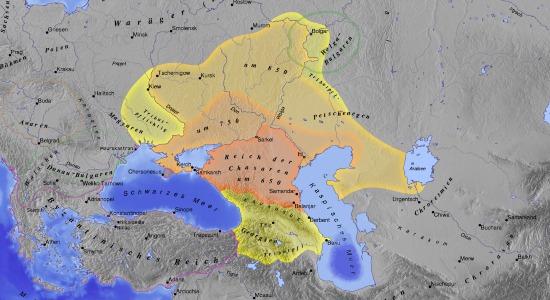
The Byzantines frequently enlisted the Khazars as allies against the muslim Middle East. A fresh, zealous and expanding religion – Islam – had founded a new empire in the region, called the Caliphate. Cooperation between Byzantium and Khazaria was instrumental in keeping this foreign policy threat at bay. Khazar invasions through the Caucasus augmented Byzantine expedition through Anatolia and Mesopotamia several times. Over time, continuous Islamic successes forced a deepening of this partnership.
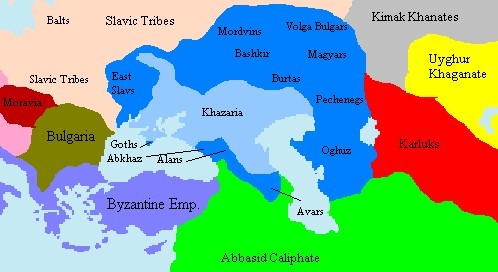
In 732, a formal alliance was concluded when the Byzantine crown prince married the daughter of the Khazar khagan. Their son eventually ascended to the throne in Constantinople as Leo “the Khazar”. The combined war effort against the muslims put the Khazars in a double bind, though. In their struggle against Islam, Khazaria bound itself increasingly tight to the intensely christian Byzantine Empire. As a result, generations of Byzantines pressed their Khazar allies into converting to Christianity – and thus into outright vassal status.
But the Khazar state consisted of adherents to several religions and even more disparate clans. Its leadership didn’t want to side officially with the christians. Rather than choosing the “lesser evil” between Jesus and Muhammad, the Khazars proudly picked a third alternative and converted to the politically “neutral” Judaism. The conversion started at the highest level, as evidenced by official correspondence between a Khazar khagan and a jewish state official of the caliphate in Córdoba.
However, the extent to which the entirety of Khazaria actually became jewish was vague, as the khaganate collapsed soon after.
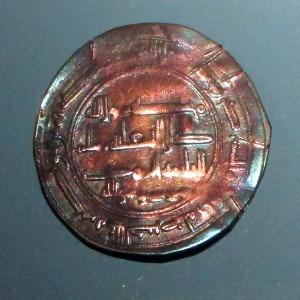
– advertisement –
– article continues below –
Artifacts from the area favor the idea that the Khazars fielded heavily armed horse-
archers, equally capable of harassing their enemies as well as smashing them in melee. What the Khazars lacked in siege equipment, their christian allies could supply. Byzantine trebuchets assisted with the sieges of a string of muslim-controlled fortresses in the Caucasus. During the 9th century, however, a new power player entered the region as an increasing number of Vikings came sailing down the Russian rivers.
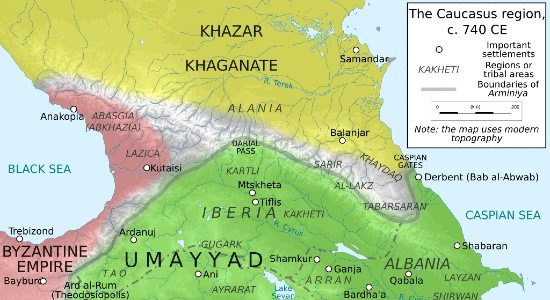
At first, the Byzantine-Khazar alliance was happy to redirect these plunder-seeking Northmen to the wealth of the caliphate – in exchange for a portion of the booty, of course. But by the end of the century, Vikings had wrested Kyiv and its surroundings from Khazar control and founded the Rus’ state there. The emperors in Constantinople now toyed with the idea of setting the Rus’ against the Khazars. With Byzantine funding, the Rus’ increased their attacks on the Khazar khaganate. During the 960s, the Grand Prince of Kyiv succeeded in shattering the imperial power of Khazaria.
Certain Khazar rump states probably lingered in the area for a while. But many Khazars probably joined successor khanates. Steppe politics are flexible after all. For example, one dissident Khazar tribe joined the Magyars on their westward migration towards Europe. But the great jewish empire of the steppe was no more around the year 1000 CE.
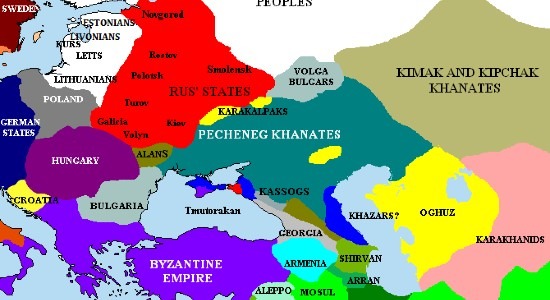
Disclosure: we work hard to provide you with exclusive medieval reports and guides. To make the Middle Ages accessible to everybody, we’d like this information to remain FREE. Therefore, some of the links below are affiliate links, meaning – at no additional cost to you – we will earn a small compensation if you click through.
Grab a short intro on another civilization from our Medieval Guidebook.